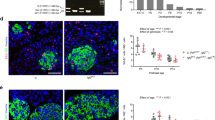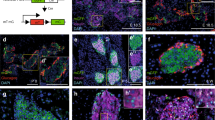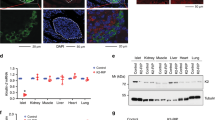Abstract
Fibroblast growth factor (FGF) signalling has been implicated in patterning, proliferation and cell differentiation in many organs, including the developing pancreas1,2. Here we show that the FGF receptors (FGFRs) 1 and 2, together with the ligands FGF1, FGF2, FGF4, FGF5, FGF7 and FGF10, are expressed in adult mouse β-cells, indicating that FGF signalling may have a role in differentiated β-cells. When we perturbed signalling by expressing dominant-negative forms of the receptors, FGFR1c and FGFR2b, in the pancreas, we found that that mice with attenuated FGFR1c signalling, but not those with reduced FGFR2b signalling, develop diabetes with age and exhibit a decreased number of β-cells, impaired expression of glucose transporter 2 and increased proinsulin content in β-cells owing to impaired expression of prohormone convertases 1/3 and 2. These defects are all characteristic of patients with type-2 diabetes. Mutations in the homeobox gene Ipf1/Pdx1 are linked to diabetes in both mouse and human. We also show that Ipf1/Pdx1 is required for the expression of FGFR1 signalling components in β-cells, indicating that Ipf1/Pdx1 acts upstream of FGFR1 signalling in β-cells to maintain proper glucose sensing, insulin processing and glucose homeostasis.
This is a preview of subscription content, access via your institution
Access options
Subscribe to this journal
Receive 51 print issues and online access
$199.00 per year
only $3.90 per issue
Buy this article
- Purchase on Springer Link
- Instant access to full article PDF
Prices may be subject to local taxes which are calculated during checkout




Similar content being viewed by others
References
Kato, S. & Sekine, K. FGF-FGFR signaling in vertebrate organogenesis. Cell. Mol. Biol. 45, 631–638 (1999).
Szebenyi, G. & Fallon, J. F. Fibroblast growth factors as multifunctional signaling factors. Int. Rev. Cytol. 185, 45–106 (1999).
Kahn, B. B. Type 2 diabetes: when insulin secretion fails to compensate for insulin resistance. Cell 92, 593–596 (1998).
Taylor, S. I. Deconstructing type 2 diabetes. Cell 97, 9–12 (1999).
Itoh, N., Mima, T. & Mikawa, T. Loss of fibroblast growth factor receptors is necessary for terminal differentiation of embryonic limb muscle. Development 122, 291–300 (1996).
Ye, W., Shimamura, K., Rubenstein, J. L., Hynes, M. A. & Rosenthal, A. FGF and Shh signals control dopaminergic and serotonergic cell fate in the anterior neural plate. Cell 93, 755–766 (1998).
Cheon, H. G., LaRochelle, W. J., Bottaro, D. P., Burgess, W. H. & Aaronson, S. A. High-affinity binding sites for related fibroblast growth factor ligands reside within different receptor immunoglobulin-like domains. Proc. Natl Acad. Sci. USA 91, 989–993 (1994).
Celli, G., LaRochelle, W. J., Mackem, S., Sharp, R. & Merlino, G. Soluble dominant-negative receptor uncovers essential roles for fibroblast growth factors in multi-organ induction and patterning. EMBO J. 17, 1642–1655 (1998).
Apelqvist, A., Ahlgren, U. & Edlund, H. Sonic hedgehog directs specialised mesoderm differentiation in the intestine and pancreas. Curr. Biol. 7, 801–804 (1997).
Edlund, H. Transcribing pancreas. Diabetes 47, 1817–1823 (1998).
Githens, S. The pancreatic duct cell: proliferative capabilities, specific characteristics, metaplasia, isolation, and culture. J. Pediatr. Gastroenterol. Nutr. 7, 486–506 (1988).
Guillam, M. T. et al. Early diabetes and abnormal postnatal pancreatic islet development in mice lacking Glut-2. Nat. Genet. 17, 327–330 (1997).
Thorens, B., Guillam, M. T., Beermann, F., Burcelin, R. & Jaquet, M. Transgenic reexpression of GLUT1 or GLUT2 in pancreatic β cells rescues GLUT2 null mice from early death and restores normal glucose-stimulated insulin secretion. J. Biol. Chem. 275, 23751–23758 (2000).
Grupe, A. et al. Transgenic knockouts reveal a critical requirement for pancreatic β cell glucokinase in maintaining glucose homeostasis. Cell 38, 69–78 (1995).
Kahn, S. E. et al. Proinsulin as a marker for the development of NIDDM in Japanese-American men. Diabetes 44, 173–179 (1995).
Larsson, H. & Ahren, B. Relative hyperproinsulinemia as a sign of islet dysfunction in women with impaired glucose tolerance. J. Clin. Endocrinol. Metab. 84, 2068–2074 (1999).
Haffner, S. M., Gonzalez, C., Mykkanen, L. & Stern, M. Total immunoreactive proinsulin, immunoreactive insulin and specific insulin in relation to conversion to NIDDM: the Mexico City diabetes study. Diabetologia 40, 830–837 (1997).
Nijpels, G., Popp-Snijders, C., Kostense, P. J., Bouter, L. M. & Heine, R. J. Fasting proinsulin and 2-h post-load glucose levels predict the conversion to NIDDM in subjects with impaired glucose tolerance: the Hoorn study. Diabetologia 39, 113–118 (1996).
Furuta, M. et al. Incomplete processing of proinsulin to insulin accompanied by elevation of Des-31,32 proinsulin intermediates in islets of mice lacking active PC2. J. Biol. Chem. 273, 3431–3437 (1998).
Jackson, R. S. et al. Obesity and impaired prohormone processing associated with mutations in the human prohormone convertase 1 gene. Nature Genet. 16, 303–306 (1997).
Blume, N. et al. Immature transformed rat islet β-cells differentially express C-peptides derived from the genes coding for insulin I and II as well as a transfected human insulin gene. Mol. Endocrinol. 6, 299–307 (1992).
Ahlgren, U., Jonsson, J., Jonsson, L., Simu, K. & Edlund, H. β-cell-specific inactivation of the mouse Ipf1/Pdx1 gene results in loss of the β-cell phenotype and maturity onset diabetes. Genes Dev. 12, 1763–1768 (1998).
van Assche, F. A. & Aerts, L. The fetal endocrine pancreas. Contrib. Gynecol. Obstet. 5, 44–57 (1979).
Hales, C. N. et al. Fetal and infant growth and impaired glucose tolerance at age 64. Br. Med. J. 303, 1019–1022 (1991).
Hellerström, C., Anderson, A., Swenne, I., Welsh, N. & Sjoholm, A. in The Pathology of the Endocrine Pancreas in Diabetes (eds Lefebvre, P. & Pipeleers, D.) 141–170 (Springer, Heidelberg, Germany, 1988).
Parsons, J. A., Brelje, T. C. & Sorenson, R. L. Adaptation of islets of Langerhans to pregnancy: increased islet cell proliferation and insulin secretion correlates with the onset of placental lactogen secretion. Endocrinology 130, 1459–1466 (1992).
Stoffers, D. A., Ferrer, J., Clarke, W. L. & Habener, J. F. Early-onset type-II diabetes mellitus (MODY4) linked to IPF1. Nature Genet 17, 138–139 (1997).
Macfarlane, W. M. et al. Missense mutations in the insulin promoter factor-1 gene predispose to type 2 diabetes. J. Clin. Invest. 104, R33–R39 (1999).
Hani, E. H. et al. Defective mutations in the insulin promoter factor-1 (IPF-1) gene in late-onset type 2 diabetes mellitus. J. Clin. Invest. 104, R41–R48 (1999).
Takumi, I., Steiner, D. F., Sanno, N., Teramoto, A. & Osamura, R. Y. Localization of prohormone convertases 1/3 and 2 in the human pituitary gland and pituitary adenomas: analysis by immunohistochemistry, immunoelectron microscopy, and laser scanning microscopy. Mod. Pathol. 11, 232–238 (1998).
Acknowledgements
We thank C. Granberg, K. Falk, U. B. Backman, the Umeå Transgene Core Facility, Mouse Camp, Karolinska Institute and U. Valtersson for technical assistance; T. Edlund for critical reading and comments; P. Hart and members from our laboratory for helpful discussions. We are grateful to A. Rosenthal for the dnFGFR1c-construct; W. LaRochelle for the dnFGFR2b-construct; O. Madsen for the proinsulin antisera and the C-peptide 1 and 2 antisera; D. Steiner for PC2 and PC1/3 antisera; B. Thorens for Glut2 antisera; and P. Serup for Nkx6.1 antisera. This work was supported by grants from the Swedish Medical Research Council and the Juvenile Diabetes Foundation, New York (to H.E.).
Author information
Authors and Affiliations
Corresponding author
Rights and permissions
About this article
Cite this article
Hart, A., Baeza, N., Apelqvist, Å. et al. Attenuation of FGF signalling in mouse β-cells leads to diabetes. Nature 408, 864–868 (2000). https://doi.org/10.1038/35048589
Received:
Accepted:
Issue Date:
DOI: https://doi.org/10.1038/35048589
This article is cited by
-
EZH2 inhibitors promote β-like cell regeneration in young and adult type 1 diabetes donors
Signal Transduction and Targeted Therapy (2024)
-
FGF-23 protects cell function and viability in murine pancreatic islets challenged by glucolipotoxicity
Pflügers Archiv - European Journal of Physiology (2023)
-
Laminin matrix regulates beta-cell FGFR5 expression to enhance glucose-stimulated metabolism
Scientific Reports (2022)
-
Structural insights into the potency and selectivity of covalent pan-FGFR inhibitors
Communications Chemistry (2022)
-
β-Arrestin-1 is required for adaptive β-cell mass expansion during obesity
Nature Communications (2021)
Comments
By submitting a comment you agree to abide by our Terms and Community Guidelines. If you find something abusive or that does not comply with our terms or guidelines please flag it as inappropriate.



